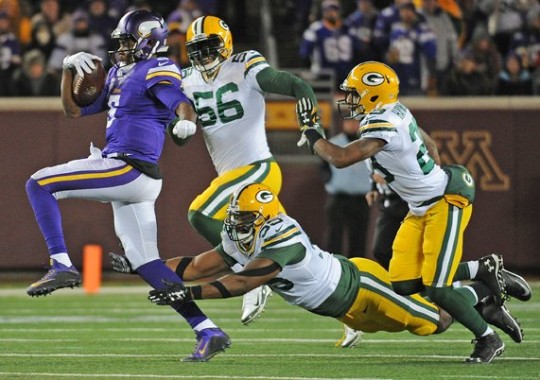It wasn’t always pretty, but the Green Bay Packers got back in the win column with a 30-13 victory over the division rival Minnesota Vikings.
The offense took a big step in the right direction, coming away with points on seven of its twelve drives. Meanwhile, the defense kept Vikings quarterback Teddy Bridgewater under pressure for the entire game and bottled up NFL rushing leader Adrian Peterson.
The Vikings defense limited the Packers offense to field goals on each of its first three possessions, but Green Bay finally broke through with a touchdown just before halftime. Quarterback Aaron Rodgers executed an 80-yard drive in just over two minutes, aided by a 50-yard pass interference penalty drawn by Jeff Janis, and found Randall Cobb down the middle of the field to give the Packers a 16-6 lead heading into the half.
The Packers tacked on a field goal to open the third quarter, but then the Minnesota offense got going. Bridgewater led the Vikings on a 63-yard drive that took just four plays, and Peterson ran the ball in from six yards out for Minnesota’s final points of the game.
At the end of the third quarter, the Packers were still holding onto their six point lead. But on the first play of the fourth quarter, Rodgers rolled to his right and connected with James Jones for a 27-yard, toe-tapping touchdown. A successful two-point conversion gave Green Bay a 27-13 lead.
The Packers were still up just two possessions, and the Vikings were driving down the field and had reached the Green Bay 32-yard line. The Packers defense, which stood tall all game, came up with a huge takeaway as Morgan Burnett forced an Adrian Peterson fumble for the only turnover by either team in the game.
The Vikings had a few more chances to get back in the game, but heavy pressure on Bridgewater on what seemed like every snap prevented Minnesota from really threatening the outcome of the game after the Peterson fumble. At the end of the game, the Packers defense had tallied six sacks, including two by Datone Jones, and numerous other pressures.
Green Bay’s defense was able to limit the top rusher in the NFL for the entire night. Peterson managed just 45 yards on 13 carries, and his longest run was 11 yards. The hardest player for the Packers to defend was tight end Kyle Rudolph, who scored Minnesota’s first touchdown after beating Micah Hyde and finished the game with a career-high 106 yards on six receptions.
For the Packers, Rodgers was still not as efficient as he has grown accustomed to being. He completed 16/34 passes for 212 yards and two scores, and was plagued by a number of drops by his receivers.
Running back Eddie Lacy seemed to get back on track for the Packers, who should look to get him more carries as the season progresses. Lacy posted season highs in carries (22) and yards (100), and returned to his punishing running style. James Jones also had his best game in over a month, leading the team with six receptions for 109 yards and a touchdown.
Moving forward, the Packers will look to turn more of their field goals into touchdowns, but the consistency of Mason Crosby was a big reason for the Packers’ highest scoring output since Week 3. Crosby connected on all five of his attempts, each of which was longer than 40 yards.
Green Bay finally got back on track in a number of ways. The running game finally got going, the deep ball was brought back to the passing attack, and the defense excelled at applying pressure on the quarterback.
The Packers lost Micah Hyde and Corey Linsley to injury in the game, and Green Bay will hope that they are ready to go on a short week. The Packers return to Green Bay for a Thanksgiving matchup with the Chicago Bears that will feature the retiring of Brett Favre’s number four.
——————Sean Blashe is a Packers fan who grew up in Bears territory and is currently a journalism and history major at Marquette University. Sean is a writer with PackersTalk.com and you can follow him on twitter at @SeanBlashe .
——————


2 responses to “Packers Get Back on Track with Victory over Vikings”
I saw substantial improvements. What the defense has trouble doing is stopping good tight ends. But Rodgers’ passes attempted to passes completed is still very unreasonable. They have a bad situation at tight end and some wide receivers are dropping an inordinate amount of passes, Adams and Cobb, for example. Going forward, I see Janis as the kick returner. This guy puts a lot of heart into his game playing.
Imagine if the defensive line had rushed that hard against the Broncos and Peyton Manning? Great effort from the DL was the key to this game.